Semimembranosus muscle: Anatomy, Origin, Insertion, Function, Structure, Exercise
Table of Contents
Introduction:
The semimembranosus muscle is the most medial of the 3 hamstring muscles in the thigh. It is so called because it has a flat tendon of origin. It is located at posteromedially in the thigh, deep to the semitendinosus muscle. It extends the hip joint & flexes the knee joint.
The other three muscles that belong to the hip extensor group are semitendinosus, biceps femoris & gluteus maximus.
The semimembranosus muscle, so called from its membranous tendon of origin, is situated at the posterior & medial side of the thigh. It is wider, flatter, & deeper than the semitendinosus muscle (with which it shares very close insertion and attachment points). The muscle overlying the upper part of the popliteal vessels.
Origin:
The semimembranosus muscle attaches by a thick tendon from the superolateral aspect of the ischial tuberosity. It arises above & medial to the biceps femoris muscle & semitendinosus muscle. The tendon of origin enlarge into an aponeurosis, which covers the upper part of the anterior surface of the muscle; from this aponeurosis, muscular fibers arise, & converge to another aponeurosis which covers the lower part of the posterior surface of the muscle & contracts into the tendon of insertion.
Insertion:
The semimembranosus muscle inserts on the:
- medial condyle of the tibia.
- medial margin of the tibia.
- intercondylar fossa of femur.
- lateral condyle of femur.
- fascia of the popliteus muscle.
The tendon of insertion gives off certain fibrous expansions. one, of considerable size, passes upward & laterally to be inserted into the posterior lateral condyle of the femur, forming part of the oblique popliteal ligament of the knee-joint; a 2nd is continued downward to the fascia which covers the popliteus muscle; while a few fibers join the medial collateral ligament of the joint & the fascia of the leg.
Function of semimembranosus muscle:
- Semimembranosus extends across both the hip & knee joints & is consequently responsible for motion about the joints. However, semimembranosus works in co-occurrence with the other hamstring muscles to carry out its function. When the feet are firmly planted on the floor, semimembranosus causes extension at the hip, which is pulls the upper torso to go into an erect position.
- Semimembranosus along with semitendinosus can also source internal rotation of the thigh when the hip is fully extended. When the legs are suspended off the floor, it causes flexion of the knee & internal rotation of the leg on the thigh.
- Semimembranosus & the other posterior thigh muscles are inactive whenever an individual is standing symmetrically. However, once the individual tilts too far forward, semimembranosus is activated & counteracts the forward movement.
Nerve supply:
The semimembranosus is supplied by the tibial part of the sciatic nerve. The sciatic nerve include of the anterior divisions of ventral nerve roots from L4 through S3. These nerve roots are the part of the wider nerve network–the sacral plexus. The Tibial part of the sciatic nerve is too responsible for innervation of semitendinosus & the long head of biceps femoris.
Variation:
The semimembranosus muscle may be reduced or absent, or double, arising mainly from the sacrotuberous ligament & giving a slip to the femur or adductor magnus.
Structure of semimembranosus muscle:
The muscle begins as a flat & membranous structure that develops a fleshy belly about midway down the thigh. The fleshy component is medially related to its tendon & the fibers are oriented inferomedially. The tendon is actually trifurcates distally to give:
the main important part that inserts on the medial tibial condyle,
a 2nd part that fuses with the popliteal fascia
and a 3rd part that becomes the oblique popliteal ligament.
Another main feature of semimembranosus is that its lateral border forms the superomedial wall of the popliteal fossa.
Relations:
The semimembranosus muscle has numerous adjacent muscular & neurovascular structures along its course. Semimembranosus is deep to semitendinosus, superficial to adductor magnus & medial to biceps femoris along its entirety. The proximal part of the muscle is covered by gluteus maximus & medial to adductor minimus. Distally, semimembranosus crosses over & becomes medially related to the medial head of gastrocnemius before inserting on the medial tibial condyle. The distal portion of the semimembranosus is also medial to the adductor canal, which accommodates the vessels of the lower limb.
There is a U-shaped bursa that surrounded the semimembranosus tendon. It separates the tendon from the medial tibial plateau, medial head of gastrocnemius, semitendinosus & the medial cruciate ligament.
The largest nerve in the human body is the sciatic nerve its travels lateral to semimembranosus until it reaches the apex of the popliteal fossa. At this point, the popliteal artery & vein are lateral to & partially covered by semimembranosus.
Blood supply:
The femoral popliteal arteries give off deep perforating branches that supply the semimembranosus muscle. Occasionally, the inferior gluteal artery supplies the proximal portion of the muscle.
Palpation of semimembranosus muscle:
Semi membranous lies deep to semitendinosus and is difficult to palpate, but can be felt easier when the knee is flexed.
Clinical importance of semimembranosus muscle:
Hamstring syndrome:
- This pathology commonly affects athletes who present with localized pain near the ischial tuberosity.
- The pathophysiology is thought to be that of an insertional tendopathy at the ischium but there may also be involvement of sciatic nerve compression.
- The pain in hamstring syndrome radiates down the posterior thigh or popliteal region and is exacerbated when the hamstrings are on tension.
- This is often seen in sprinters or hurdlers. On examination there is exquisite tenderness over the ischial tuberosity & percussion in that region may reproduce the sciatic distribution of pain.
- Treatment involves rest, anti-inflammatory agents & steroid injections.
Baker’s cyst
- The bursae that separates the muscle from the medial head of the tibia & the medial head of the Gastrocnemius may at times become enlarged with distended fluid.
- This swelling is known as ‘Baker’s cyst’ .
Regularly doing stretching and strengthening exercises, and warming up before exercise, may help reduce the threat of injuring your semi-membranous muscle.
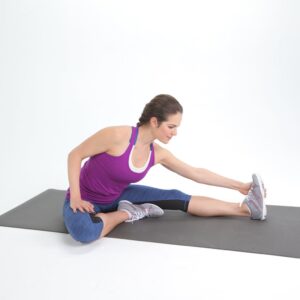
Stretching exercise of Semimembranous muscle
1. Semimembranous stretching
Standing upright, facing a bench, table OR horizontal bar, flex the hip & ‘locking out’ knee & place this straight leg upon the anchor point.
To increase this stretch, lean forward at the hip & reach toward the toes.
- Functional movements
- Stand from sitting
- Walking upstairs
- Standing jump forwards
- Standing jump upwards

2.Hamstring muscle stretch:
- Sit on the ground with both legs are out straight.
- Extend the arms & reach forward by bending at the waist as far as possible while keeping the knees straight.
- Hold this position for 15-30 seconds.
- Relax back into the starting position.
- Repeat three times.

Be sure to stretch until a moderate pull is felt in the back of the thighs. If you are feel any excessive pain, you might be stop the exercise.
3. Hurdler hamstring muscle stretch:
- Sit on the ground with one leg are out straight.
- Bend the other leg at the knee & position the sole of that foot against the opposite inner thigh.
- Extend the arms & reach forward over the one straight leg by bending at the waist as far as possible.
- Hold this position for 15 seconds.
- Relax and than Repeat with the other leg.
4. Standing hamstring muscle stretch( Both legs are together):
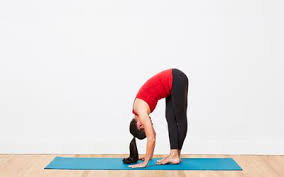
( Both legs are together)
This hamstring stretch is a simple one to do anywhere at the all. It is done in the standing position & stretches both legs at once. Here is how you to do the standing hamstring stretch:
- Stand & cross the right foot in front of the left.
- Slowly lower the forehead to the right knee joint by bending at the waist.
- Keep the both knees straight.
- Hold this position for 15-30 seconds.
- Relax and then Repeat for the other side by crossing the left foot in front of the right.
5. Standing hamstring muscle stretch (one leg at a time)
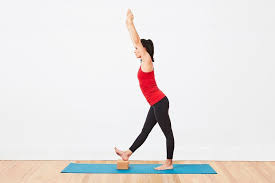
The one-legged standing hamstring stretch is completely possibly the easiest hamstring stretch to do. It can be done anywhere home, office, or outdoors & it requires no special tools.
- Stand up the straight with one heel resting on a small stool. if it is outside, one can use the curb, but be sure to watch for cars.
- Keep the knee straight.
- Reach both arms up toward the place where the wall & ceiling meet. If outside where there is no wall and ceiling, when simply reach up into the air so that the arms are about even with the ears. Reaching the arms up and as opposed to reaching down toward the foot, will keep the back straight.
- Keep the back straight & One should be bending forward slightly from the hips.
- Reach the forward & feel a stretch in the hamstring behind the thigh.
- Hold this position for 15-30 seconds, & repeat 3 times.
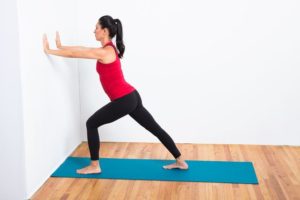
7. Runner’s hamstring stretch
The runner’s stretch is a common flexibility exercise for hamstrings
- Stand one foot from a wall & place the hands on the wall at shoulder height, shoulder width apart.
- Take a step back with 1 leg while pushing into the wall
- Keep the back straight & press the heels into the floor.
- Hold for 15-30 seconds.
- Step forward and the repeat with the other leg.
- Repeat the exercise 3 times on each side.
Strengthening exercise of Semimembranous muscle
1. Static Hamstring contraction

- Start this exercise in sitting with the knee bent to about 45 degrees.
- Press the heel into the ground tightening the back of thigh.
- Hold for 5 seconds & repeat 10 times as hard as possible pain free.
2.Bridging exercise
- Start this exercise lying on the back in the supine position.
- Gradually, lift the bottom pushing through feet, until the knees, hips & shoulders are in a straight line.
- Tighten the back of the thigh while performing this exercise.
- Hold for 3-5 seconds then slowly lower the bottom of the back down.
- Perform this exercise 3 sets of 10 repetitions provided the exercise is pain free.
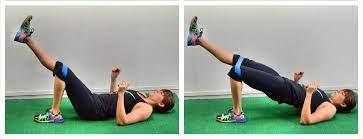
3. Single leg bridging
- Lie flat on the back with the knees bent & feet flat on the floor. The feet & knees might be hip distance apart.
- Tighten the abdominal muscles slightly to engage the core and stabilise the lower back.
- Lift up into simple bridge position but as one hold the bridge position, lift 1 foot off the floor & extend the knee as shown.
- Hold for 3-5 seconds, bring the foot back down, & then lower the buttocks to the floor.
4. Hamstring curls with gym ball:
- Lies on the back with the feet & lower calves resting on a gym ball with knees straight & arms crossed over the chest.
- Slowly curl the ball towards the body by bending the knees & then slowly roll the ball away.
- Repeat this exercise for 10 times.
5. Lower your hips down for a single rep
- Do 2 or 3 sets of 10-15 repetitions on each side.
- Advanced: You can make this move harder by placing a barbell & a weighed plate on your hips.
6. Box Squats :
- Stand in front of a bench, chair, or box that is 16-25 inches off the floor.
- Stand facing away from the box with a slightly wider stance & your toes slightly pointing out.
- Holding a weighed barbell in front of your chest & keeping your back firm, lower into a squat until your butt touches the surface. Return to standing. Do not let your knees go over the toes.
- One squat is a single rep. Do 10 to 15 reps 2 or 3 times.
7. One-Legged Dead lift :
- As you do this move, remember to keep your back straight and rotate from the hip.
- Holding a barbell or kettle bell in one hand, hinge forward at the hip, simultaneously extending the opposite leg straight behind you.
- Keep your back straight and lower your torso until your leg is parallel to the floor. If balance is an issue you can keep the toe of your back foot lightly touching the floor.
- Return to standing.
- Do 2 or 3 sets of 10 to 15 repetitions on each side.
8. Lying Leg Curls :
- This machine-based move is highly effective because it completely isolates the hamstring.
- When completing this move, be sure to focus on controlling the movement and go as slowly as possible, as you don’t want to use inertia to move the weights as you curl your feet closer to your rear.

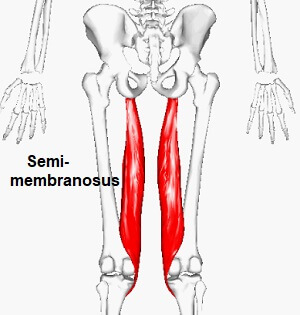
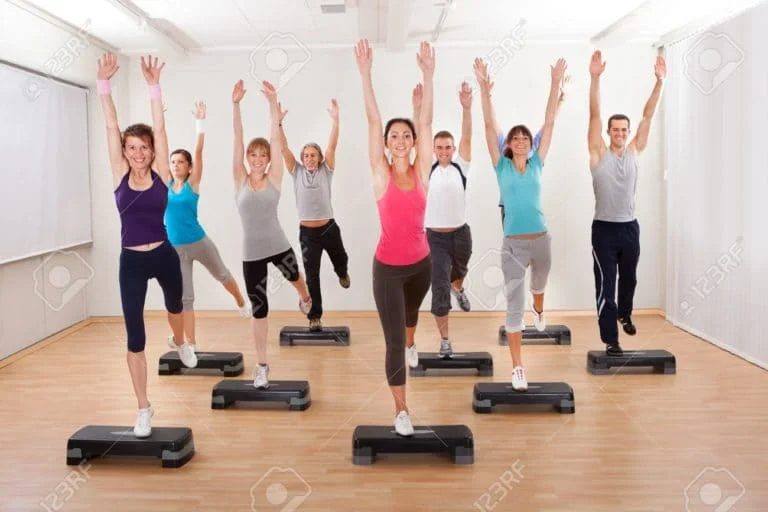
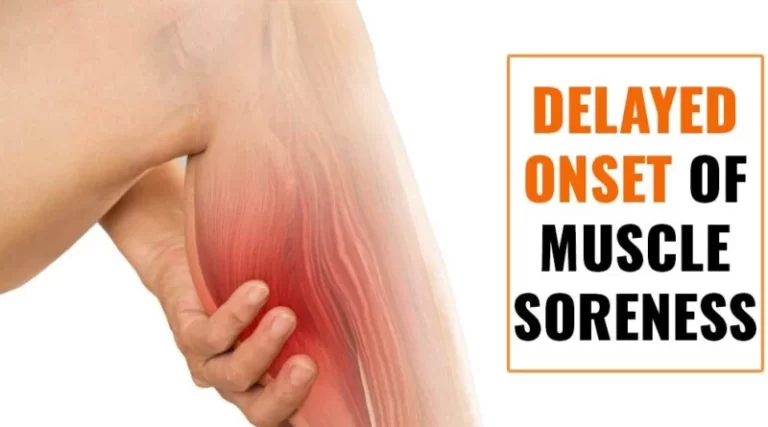
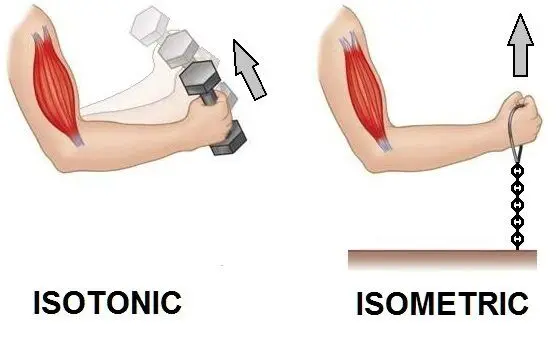
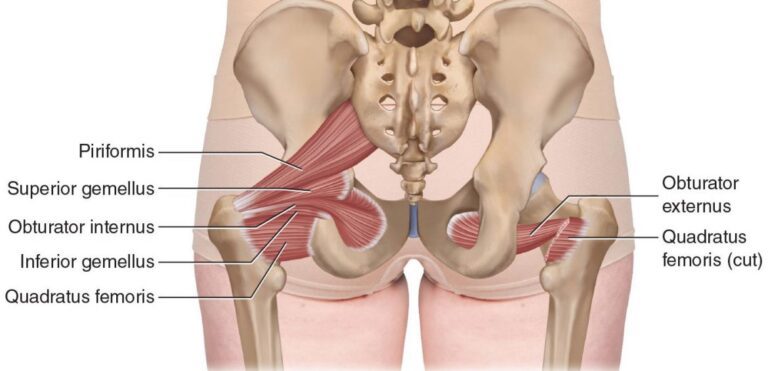
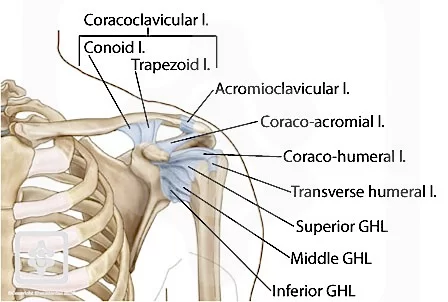
2 Comments